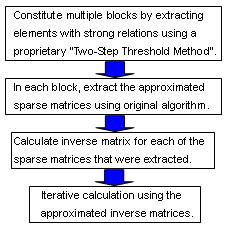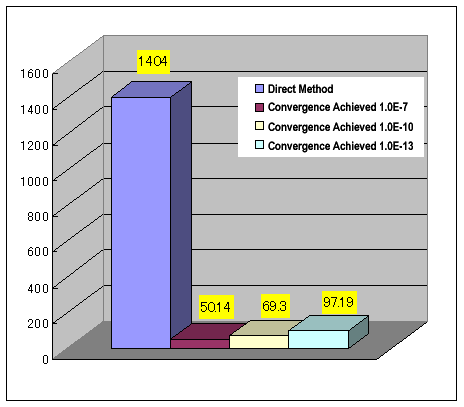| Items |
Descriptions |
Notes |
| Target Coefficient Matrix |
Dense matrices that are generated
with boundary element method (BEM). |
Calculates dense matrices; however,
performs well for sparse matrices. |
| Types of Unknowns |
Real (double) and Complex Numbers. |
|
| Solution Method |
Pre-processing + Iterative Method |
|
| Data Giving Method |
1. Give coefficient matrix A, right-hand-side
vector b, etc. as arguments. The result is also returned as
arguments. 2. Loading the data (e.g. coefficient matrix A and
right-hand-side vector b) that was once dumped into a file.
The result is also returned as a file. |
1. Small to medium size problems
with fewer than 14,000 unknowns. 2. Large size problems that
exceeds 14,000 unknowns. |
| Limit of Unknowns |
None. Basically calculates with
actual (IN-CORE) memory. In case of memory insufficiency, calculates
with OUT-OF-CORE capability. Allows for setting of the amount
of actual (usable) memory. |
|
| Parameters |
1) Target Convergence 2) Number
of Iteration 3)Amount of Memory Allocated |
1 and 2 can be assigned because
this solution method is based on iterative method. Target convergence
specified by relative residual in L2 norm. |
| Other Conditions |
Dump the data as 1D array so that
i-th column and j-th element of the coefficient matrix A, and
the k-th element of the 1D array relate as follows: k=(i-1)*n+j
where n is the number of unknowns. |
Enter the data row by row in a sequence
(enter the 1st row, then the 2nd, 3rd and so forth). |
| Method of Provision |
DLL format for Windows; Static library
format for Linux and UNIX. |
Source code will not be disclosed. |
| Memory Requirement Estimation |
For IN-CORE calculation, memory
addition is required that is 0.1 to 0.3 times as large as the
size of the coefficient matrix A. (i.e. for the matrix size
of S, the seize of required memory is 1.1S to 1.3S) OUT-OF-CORE
calculation is possible with small amount of memory (e.g. 1/10
or less the size of the coefficient matrix A). However, larger
the amount of usable memory, faster the calculation speed.
Fastest calculation time may be attained by giving an entire
memory to the solver by freeing the memory allocated by other
sub-routine. |
Breakthrough in requirement for
fewer amount of memory compared to the conventional solution
method that requires large amount of memory. |
| Calculation Time |
Proportional to the squares of the
size of coefficient matrix A (in case of IN-CORE). |
|

